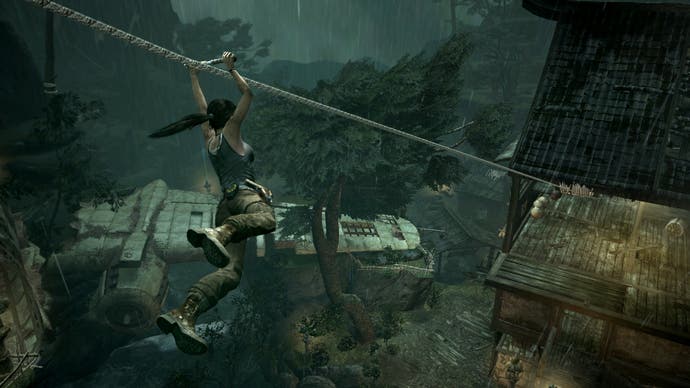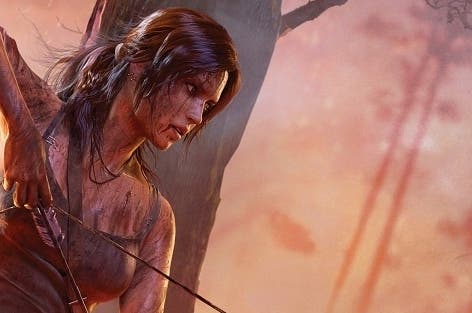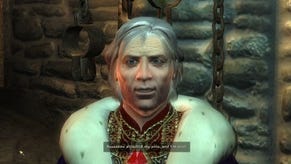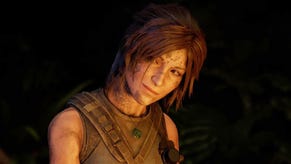Tomb Raider: the model of a modern megagame
Will Lara find or lose herself amid all - and we do mean all - the trimmings of a 2013 blockbuster?
With their reboot of Tomb Raider, developer Crystal Dynamics and publisher Square Enix are going for the jugular. And I don't just mean in the savage scenes where Lara must defend herself from rabid wolves by ripping their throats open with an arrow.
After three hours playing the game, it's clear that no expense has been spared on this reinvention of the action-adventure series and its iconic heroine Lara Croft. No trend has been left unfollowed, either. Tomb Raider is an exhaustively complete collection of fashions in contemporary blockbuster game-making.
Graphic violence, bad language, gritty art, brutal finishing moves, shaky-cam quick time events, experience points and upgrade trees, mini meta-challenges, 'detective mode', survivalist gameplay, stealth assassinations, collectable backstory, a lead character on a personal journey: it's got the lot. You'll run, jump and raid tombs, of course, but you'll also harvest resources, craft weapon upgrades, press Y to execute and then cry at the cut-scene. (Maybe.)
If you can still discern the outline of classic Tomb Raider through this blizzard of relevance - and you can - it's partly because you can trace so much of contemporary gaming back to the game and character created by Core Design and Toby Gard back in 1996. That's especially true of Uncharted and Assassin's Creed, two of the biggest influences here, so it stands to reason that Lara has more right to help herself to their style and substance than most. But, playing the game, you can't shake the image of a boardroom meeting in which some senior publishing executive handed over a shopping list of every feature he'd ever heard of working in his competitors' most successful games.

At least that guy seems to have written a blank cheque to go with it. The first and last things that strike you about Tomb Raider are the simply stunning animation, camerawork and art direction. We pick things up right at the game's start; Lara, a precocious young archaeology student, is shipwrecked in the mysterious "Dragon's Triangle" south of Japan. Her expedition, which includes a small TV crew working with a flaky celebrity archaeologist called Dr Whitman, is looking for the fabled island of Yamatai, once supposedly ruled by a queen with shamanistic powers. They seem to have found it, but they're not alone.
She's knocked unconscious and separated from the rest of her expedition, waking up hanging upside down and bound in a sort of cocoon. The game's tone is quickly set as she encounters the gruesome corpse of a torture victim and is pursued by a snarling, threatening, barely-seen man.
Yes, there are overtones of horror here - and yes, sometimes (but rarely) there are undertones of sexual violence, as the shireking, bloodied Lara, lying prone, has to frantically defend herself from assault. But I'm not going to dwell on that issue here (Ellie discussed it with lead writer Rhianna Pratchett in a recent interview). Suffice to say that these scenes do make an impression, but it's one that needs to be taken in context - and one which has already started to fade by the end of the game's first act.
At any rate, the TV series Lost is certainly a bigger influence than torture porn cinema. Lara and the survivors are sharing the island with a sinister gang, a strange force and the traces of earlier visitors. This is no Polynesian paradise, though; it's an impressively moody place lit through storm clouds by a watery sun, craggy and wild and ancient. It's this atmosphere that pulls you in; the dense, glowering artwork is exploited to the full by a brilliant camera that cuts smoothly from gameplay clarity to spectacular reveals and edgy, handheld-style close shots.
With quite a large supporting cast, it's not a lonely adventure, but Lara is almost always alone during gameplay - as it should be. Linear, story-led sections that will feel familiar to Uncharted fans link tight but more organically designed open areas where you're free to explore, scramble, scavenge and hunt as you search for the way forward.
It's in these areas that the game's modish advancement systems come to the fore. The prominent hunting seems to suggest some kind of food-based survival mechanic that hasn't made the cut, since you just end up looting "salvage" from your prey - this, also found in crates scattered around, is the currency used to upgrade weapons and tools. Lara also earns experience from all kinds of activities, allowing her to unlock survival abilities from exploration and stealth perks to combat moves.
"Within minutes, we're whisked from Lara calming her trembling hands with a gasp of 'I can do this!' to calmly popping off headshots for bonus XP."

It's not all bandwagon-jumping. In a lovely return to - in fact, extension of - the tomb raiding concept, you can stumble across secret "challenge" tombs as you explore the areas. These micro-dungeons present a puzzle to solve and a treasure chest to loot and are as close to the Indiana Jones action-archeologist fantasy as anything in the series ever has been.
It's just as well, because in the first few hours, the main path through the game presents only a very small handful of puzzles. Though not tough, they're satisfying and fun to solve thanks to an emphasis on physics - pulley systems, weight and buoyancy - that recalls Half-Life 2.
Unsurprisingly, combat is much quicker to come to the fore. There are stealthy sections where Lara can creep up on the Scavenger gang and execute them from behind, or snipe them with her bow, segueing into full-on gun battles. It's a bit dispiriting to come across an armoured, riot-shield-toting "heavy" who could so easily have wandered out of some schlocky C-list blaster like Army of Two, but the gunplay is fine and the action is better paced than in many rival games.
It does present Pratchett with something of a problem, however. She and the game's producers have hung their hat on (and defended the game's ugly marketing with) the idea that Tomb Raider will depict a vulnerable Lara progressively learning the skills and finding the inner strength that made her the badass we all know and love.
But the extremely violent action doesn't give the writers any room to explore this. Within minutes, we're whisked from Lara calming her trembling hands with a gasp of "I can do this!" to calmly popping off headshots (for bonus XP) or bashing bad guys in the face with a rock as a melee finisher. And then we're whisked back to the frail young thing again, with a weak reference to "working the late shift at the Nine Bells" explaining away her homicidal aptitude. [Correction: It's been pointed out to me that I misremembered the context of this line and it actually refers to Lara's ability to dress a wound. -Oli]

Lara's not the first video game star to stumble into this particular paradox, of course, but this reboot's ambitious handling of its lead character highlights it in particularly stark terms. It also illustrates just how tangled Crystal Dynamics could get in the web of contradiction that's inherent in a game that's looking to reinvent and humanise a much-loved character as well as tick every last box in its pursuit of the action-game zeitgeist.
There's a lot that's very impressive about Tomb Raider regardless, however, and there are a few moments that suggest the team knows just the route to take through this maze. The set-piece that ends this first act - I won't spoil it - is a playable scene as simple as it is quietly breathtaking.
It's not about peeling away another layer of advancement or shopping for upgrades. It's not about sex or violence. Nor is it about solving some ancient mechanical riddle or clambering to a distant ledge. It's about mastering the world around you, alone, with nothing more than your bravery, athleticism and sense of adventure. That's Tomb Raider, alright.












.png?width=291&height=164&fit=crop&quality=80&format=jpg&auto=webp)



